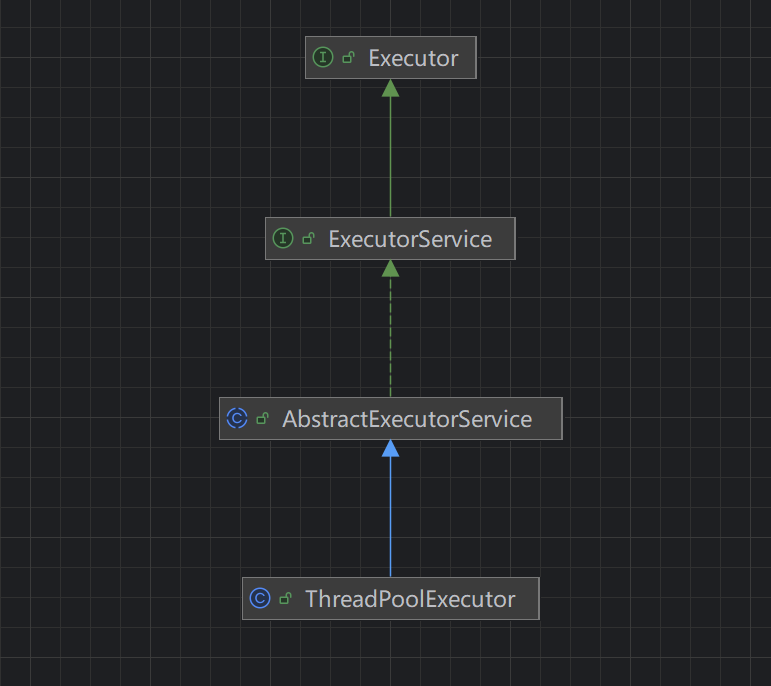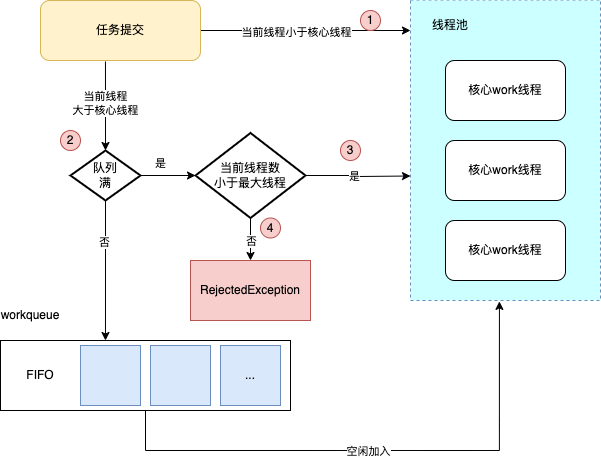ThreadPool
关于Executor的介绍,在 Java基础-线程池基础(Executors) 已经讲述过,此处只着重介绍 ThreadPoolExecutor相关的处理方案,以下为参考文章:
一、什么是线程池?
说到 线程池,其实我们要先聊到 池化技术。
池化技术:我们将资源或者任务放入池子,使用时从池中取,用完之后交给池子管理。通过优化资源分配的效率,达到性能的调优。
池化技术优点:
- 资源被重复使用,减少了资源在分配销毁过程中的系统的调度消耗。
Tips
比如,在IO密集型的服务器上,并发处理过程中的子线程或子进程的 创建和销毁过程,带来的系统开销将是难以接受的。 所以在业务实现上,通常把一些资源预先分配好,如线程池,数据库连接池,Redis连接池, HTTP连接池等,来减少系统消耗,提升系统性能。
池化技术分配资源,会集中分配,这样有效避免了碎片化的问题。
可以对资源的整体使用做限制,相关资源预分配且只在预分配后生成,后续不再动态添加,从而限制了整个系统对资源的使用上限。
所以我们说线程池是 提升线程可重复利用率、可控性的池化技术的一种。
二、线程池的底层原理
1、类继承视图

2、构造函数说明
public ThreadPoolExecutor(int corePoolSize,
int maximumPoolSize,
long keepAliveTime,
TimeUnit unit,
BlockingQueue<Runnable> workQueue,
ThreadFactory threadFactory,
RejectedExecutionHandler handler) {
if (corePoolSize < 0 ||
maximumPoolSize <= 0 ||
maximumPoolSize < corePoolSize ||
keepAliveTime < 0)
throw new IllegalArgumentException();
if (workQueue == null || threadFactory == null || handler == null)
throw new NullPointerException();
this.acc = System.getSecurityManager() == null ?
null :
AccessController.getContext();
this.corePoolSize = corePoolSize;
this.maximumPoolSize = maximumPoolSize;
this.workQueue = workQueue;
this.keepAliveTime = unit.toNanos(keepAliveTime);
this.threadFactory = threadFactory;
this.handler = handler;
}
下面我们来解释一下几个参数的含义:
corePoolSize:核心线程数。
maximumPoolSize:最大线程数。
keepAliveTime:线程池中线程的最大闲置生命周期。
unit:针对keepAliveTime的时间单位。
workQueue:阻塞队列。
threadFactory:创建线程的线程工厂。
handler:拒绝策略。
3、工作流程概述

流程解析
当发起任务时候,会计算线程池中存在的线程数量与核心线程数量(corePoolSize)进行比较,如果小于,则在线程池中创建线程,否则,进行下一步判断。
如果不满足条件1,则会将任务添加到阻塞队列中。等待线程池中的线程空闲下来后,获取队列中的任务进行执行。
但是条件2中如果阻塞队列满了之后,此时又会重新获取当前线程的数量和最大线程数(maximumPoolSize)进行比较,如果发现小于最大线程数,那么继续添加到线程池中即可。
4.如果都不满足上述条件,那么此时会放到拒绝策略中。
4、execute核心流程
/**
* Executes the given task sometime in the future. The task
* may execute in a new thread or in an existing pooled thread.
*
* If the task cannot be submitted for execution, either because this
* executor has been shutdown or because its capacity has been reached,
* the task is handled by the current {@code RejectedExecutionHandler}.
*
* @param command the task to execute
* @throws RejectedExecutionException at discretion of
* {@code RejectedExecutionHandler}, if the task
* cannot be accepted for execution
* @throws NullPointerException if {@code command} is null
*/
public void execute(Runnable command) {
if (command == null)
throw new NullPointerException();
/*
* Proceed in 3 steps:
*
* 1. If fewer than corePoolSize threads are running, try to
* start a new thread with the given command as its first
* task. The call to addWorker atomically checks runState and
* workerCount, and so prevents false alarms that would add
* threads when it shouldn't, by returning false.
*
* 2. If a task can be successfully queued, then we still need
* to double-check whether we should have added a thread
* (because existing ones died since last checking) or that
* the pool shut down since entry into this method. So we
* recheck state and if necessary roll back the enqueuing if
* stopped, or start a new thread if there are none.
*
* 3. If we cannot queue task, then we try to add a new
* thread. If it fails, we know we are shut down or saturated
* and so reject the task.
*/
int c = ctl.get();
if (workerCountOf(c) < corePoolSize) {
if (addWorker(command, true))
return;
c = ctl.get();
}
if (isRunning(c) && workQueue.offer(command)) {
int recheck = ctl.get();
if (! isRunning(recheck) && remove(command))
reject(command);
else if (workerCountOf(recheck) == 0)
addWorker(null, false);
}
else if (!addWorker(command, false))
reject(command);
}
5、BlockingQueue
6、拒绝策略说明
7、线程池最优参数
常见的区分cpu和io密集型
三、动态线程池
此处查看详情:dynamictp
